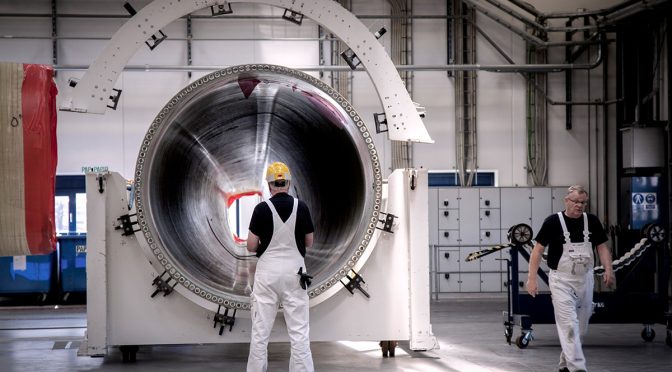The EU wants to massively expand renewables and strengthen Europe’s clean energy supply chains. But its Net-Zero Industry Act (NZIA) falls short and needs beefing up. If Europe gets NZIA wrong, it’ll end up building wind farms with turbines manufactured outside of Europe, many of them in China. New data shows what’s at stake economically.
Wind energy is key to Europe’s energy security and climate targets. The EU want it to be 43% of Europe’s electricity consumption by 2030, up from 17% today. That means building 30 GW of new wind farms every year.
Nearly all wind farms Europe has built up until today use turbines made in Europe. There are over 250 factories around Europe making turbines and components. But there are already bottlenecks in Europe’s wind supply chain. Offshore foundation manufacturers and installation vessels are fully booked for several years. The wind industry is having to buy power cables, gearboxes and even steel towers from China. We’re building a few new factories but not enough for the massive expansion of wind energy that Europe now needs.
Huge investments are needed now: in factories, ports, girds, vessels, cranes and skilled workers.
Need to beef up the NZIA
The rapid expansion needed in Europe’s wind and other clean energy supply chains requires public policy and public financial support. The EU totally gets this – which is why they came up with their Green Deal Industrial Plan. But the NZIA which is at the heart of the Plan, falls a long way short of what is needed. It badly needs beefing up.
The European Parliament and EU Member States in the Council are now amending the NZIA text.
A key thing to strengthen are the non-price criteria in renewables auctions. It’s good that these will now be compulsory. Using only price in auctions has driven a ‘race to the bottom’. Bringing in non-price criteria will reward the social, economic and environmental value that Europe’s clean energy industries offer. They will incentivise innovative solutions to sustainability, biodiversity protection and system integration.
But the current text is timid on what criteria can be used:
- it talks about “supply chain resilience”. The most resilient supply chain is local. Let’s spell out that auctions should give extra points to developers who offer European technology;
- let’s add something on cybersecurity. We don’t want to build equipment that’s exposed to cyber-attacks;
- let’s add “due diligence” too. We can’t be sourcing kit from places with questionable human rights records, or loose standards on labour and environmental protection; and
- let’s drop the idea that you don’t need to apply non-price criteria whenever costs go up by 10%. It’s impossible to apply in practice and defeats the purpose for having non-price criteria in the first place.
The costs of getting NZIA wrong are huge
The costs of getting all this wrong are huge. Constraints in Europe’s wind energy supply chain mean Chinese turbine manufacturers are now starting to win orders here, not least with their cheaper turbines, looser standards and unconventional financial terms (pay us only on completion of the wind farm or later). There is a very real risk that the expansion of wind energy Europe will be made in China not in Europe.
Quite apart from the new dependencies that would create just when we’re trying to improve Europe’s energy security, the economic losses would be huge. Latest data shows the European wind energy industry, with its 300,000 employees, contributed €42bn to EU GDP in 2022. Each new wind turbine installed in Europe generated on average €11m of economic activity. And the wind industry paid €7bn in taxes, including local taxes paid to communities living close to the wind farms.
It’s a volume not an innovation game
Alongside NZIA, the new EU state aid rules allow Member States to support investments in new factories making clean energy equipment. Good – national Government should exploit this to the fullest. But it’s essential that the EU also puts its own money on the table. The new Sovereignty Fund cannot come soon enough. And the Innovation Fund needs less emphasis on technology breakthroughs and more on simply building out the manufacturing capacity in Europe – especially for those technologies that are ready to deliver the big volumes of clean energy Europe needs.
At the same time Europe needs to keep a razor-sharp focus on the simplification of permitting rules and procedures. The bottlenecks here mean we’re only building half the new wind farms Europe needs. The helpful new EU rules and deadlines should make a difference. In Germany where they’re already being implemented, the number of new permits is up, and legal appeals are being unblocked. Other countries need to implement the rules as soon as possible.
And Europe needs to accelerate the build-out of electricity grids. Too many new wind farms are delayed because the grid connection isn’t ready, or the TSO has a huge backlog of grid connection applications.
“Europe wants a green industrial policy. It wants renewables to be made in Europe. But it’s failing on the policies that will actually deliver that. The Net-Zero Industry Act needs beefing up. Public money has to support the expansion of green supply chains, as it does elsewhere in the world. Otherwise the EU Green Deal will be manufactured outside of Europe, and Europe will simply swap its dependency on Russian gas for one on Chinese clean energy equipment. Our existing green supply chains bring jobs, growth and investment to thousands of communities. We’ve got to wake up and preserve that AND build on it. NZIA is our chance. We mustn’t blow it”, says WindEurope CEO Giles Dickson.


